Selina Class 10 ICSE Chapter 3 Machines // Solution
Chapter 3 - Machines Exercise Ex. 3A
Question 1
(a) What do you understand by a simple machine?
(b) State the principle of an ideal machine.
Solution 1
(a) A machine is a device by which
we can either overcome a large
resistive force at some point by
applying a small force at a convenient
point and in a desired direction or by
which we can obtain a gain in the
speed.
we can either overcome a large
resistive force at some point by
applying a small force at a convenient
point and in a desired direction or by
which we can obtain a gain in the
speed.
(b) An ideal machine is a machine
whose parts are weightless and
frictionless so that which there is no dissipation of energy in any manner.
Its efficiency is 100%, i.e. the work
output is equal to work input.
whose parts are weightless and
frictionless so that which there is no dissipation of energy in any manner.
Its efficiency is 100%, i.e. the work
output is equal to work input.
Question 2
State four ways in which machines are useful to us?
Solution 2
Machines are useful to us in the following ways:
(1) In lifting a heavy load by applying a less effort.
(2) In changing the point of application of effort to a convenient point.
(3) In changing the direction of effort to a convenient direction.
(4) For obtaining a gain in speed.
Question 3
Name the machine for each of the following use:
(a) to multiply the force,
(b) to change the point of application of force,
(c) to change the direction of force,
(d) to obtain the gain in speed.
Solution 3
(a)To multiply force: a jack is used to lift a car.
(b)To change the point of application of force: the wheel of a cycle is rotated with the help of a chain by applying the force on the pedal.
(c)To change the direction of force: a single fixed pulley is used to lift a bucket full of water from the well by applying the effort in the downward direction instead of applying it upwards when the bucket is lifted up without the use of pulley.
(d)To obtain gain in speed: when a pair of scissors is used to cut the cloth, its blades move longer on cloth while its handles move a little.
Question 4
What is the purpose of a jack in lifting a car by it?
Solution 4
The purpose of jack is to make the effort less than the load so that it works as a force multiplier.
Question 5
What do you understand by an ideal machine? How does it differ from a practical machine?
Solution 5
An ideal machine is a machine whose parts are weightless and frictionless so that which there is no dissipation of energy in any manner. Its efficiency is 100%, i.e. the work output is equal to work input.
Ideal machine
|
Practical machine
|
1. Efficiency is 100%.
|
1. Efficiency is less than 100%
|
2. Its parts are weightless, elastic and perfectly smooth.
|
2. Its parts are not weightless, elastic or perfectly smooth.
|
3. There is no loss in energy due to friction.
|
3. There is always some loss of energy due to friction.
|
4. Work output of such a machine is equal to the work input.
|
4. Work output is always less than the work input.
|
Question 6
Explain the term mechanical advantage. State its unit.
Solution 6
The ratio of the load to the effort is called mechanical advantage of the machine. It has no unit.
Question 7
Define the term velocity ratio. State its unit.
Solution 7
The ratio of the velocity of effort to the velocity of the load is called the velocity ratio of machine. It has no unit.
Question 8
How is mechanical advantage related to the velocity ratio for (i) an ideal machine, (ii) a practical machine?
Solution 8
For an ideal machine mechanical advantage is numerically equal to the velocity ratio.
Question 9
Define the term efficiency of a machine. Give two reasons for a machine not to be 100% efficient?
Solution 9
It is the ratio of the useful work done by the machine to the work put into the machine by the effort.
In actual machine there is always some loss of energy due to friction and weight of moving parts, thus the output energy is always less than the input energy.
Question 10
When does a machine act as (a) a force multiplier and (b) a speed multiplier? Can a machine act as a force multiplier and speed multiplier simultaneously?
Solution 10
(a) A machine acts as a force multiplier when the effort arm is longer than the load arm. The mechanical advantage of such machines is greater than 1.
(b) A machine acts a speed multiplier when the effort arm is shorter than the load arm. The mechanical advantage of such machines is less than 1.
It is not possible for a machine to act as a force multiplier and speed multiplier simultaneously. This is because machines which are force multipliers cannot gain in speed and vice-versa.
Question 11
A machine works as a (i) force multiplier, (ii) speed multiplier. In each case state whether the velocity ratio is more than or less than 1.
Solution 11
(i) For a machine working as a force multiplier, displacement of load is less than displacement of effort. Thus, the velocity ratio is more than 1.
(ii) For a machine working as a speed multiplier, displacement of load is more than displacement of effort. Thus, the velocity ratio is less than 1.
Question 12
(a) State the relationship between mechanical advantage, velocity ratio and efficiency.
(b) Name the term that will not change for a machine of a given design.
Solution 12
Mechanical advantage is equal to the product of velocity ratio and efficiency.
For a machine of a given design, the velocity ratio does not change.
Question 13
Derive the relationship between mechanical advantage, velocity ratio and efficiency of a machine.
Solution 13
Let a machine overcome a load L by the application of an effort E. In time t, let the displacement of effort be dE and the displacement of load be dL.
Work input = Effort X displacement of effort
= E X dE
Work output = Load X displacement of load
= L X dL
Efficiency 

Thus, mechanical advantage of a machine is equal to the product of its efficiency and velocity ratio.
Question 14
How is the mechanical advantage related with the velocity ratio for an actual machine? State whether the efficiency of such a machine is equal to 1, less than 1 or more than 1.
Solution 14
The mechanical advantage for an actual machine is equal to the product of its efficiency and velocity ratio.
The efficiency of such a machine is always less than 1, i.e. h
Question 15
State one reason why is mechanical advantage less than the velocity ratio for an actual machine.
Solution 15
This is because the output work is always less than the input work, so the efficiency is always less than 1 because of energy loss due to friction.
Question 16
What is a lever? State its principle.
Solution 16
A lever is a rigid, straight or bent bar which is capable of turning about a fixed axis.
Principle: A lever works on the principle of moments. For an ideal lever, it is assumed that the lever is weightless and frictionless. In the equilibrium position of the lever, by the principle of moments,
Moment of load about the fulcrum=Moment of the effort about the fulcrum.
Question 17
Write down a relation expressing the mechanical advantage of a lever.
Solution 17
This is the expression of the mechanical advantage of a lever.
Question 18
Name the three classes of levers and state how are they distinguished. Give two examples of each class.
Solution 18
The three classes of levers are:
(i)Class I levers: In these types of levers, the fulcrum F is in between the effort E and the load L. Example: a seesaw, a pair of scissors, crowbar.
(ii)Class II levers: In these types of levers, the load L is in between the effort E and the fulcrum F. The effort arm is thus always longer than the load arm. Example: a nut cracker, a bottle opener.
(iii)Class III levers: In these types of levers, the effort E is in between the fulcrum F and the load L and the effort arm is always smaller than the load arm. Example: sugar tongs, forearm used for lifting a load.
Question 19
Give one example each of a class I lever where mechanical advantage is (a) more than 1, and (b) less than 1.
Solution 19
(a) More than one: shears used for cutting the thin metal sheets.
(b)Less than one: a pair of scissors whose blades are longer than its handles.
Question 20
What is the use of lever if its mechanical advantage is (a) more than 1, (b) equal to 1, and (c) less than 1?
Solution 20
When the mechanical advantage is less than 1, the levers are used to obtain gain in speed. This implies that the displacement of load is more as compared to the displacement of effort.
Question 21
Both a pair of scissors and a pair of pliers belong to the same class of levers. Name the class of lever. Which one has the mechanical advantage less than 1?
Solution 21
A pair of scissors and a pair of pliers both belong to class I lever.
A pair of scissors has mechanical advantage less than 1.
Question 22
Explain why scissors for cutting cloth may have blades longer than the handles, but shears for cutting metals have short blades and long handles.
Solution 22
A pair of scissors used to cut a piece of cloth has blades longer than the handles so that the blades move longer on the cloth than the movement at the handles.
While shears used for cutting metals have short blades and long handles because as it enables us to overcome large resistive force by a small effort.
Question 23
Figure shows a uniform metre scale of weight W supported on a fulcrum at the 60 cm mark by applying the effort E at the 90 cm mark.
(a) State with reasons whether the weight W of the rule is greater than, less than or equal to the effort E.
(b) Find the mechanical advantage in an ideal case.

Solution 23
(a) The weight W of the scale is greater than E.
It is because arm on the side of effort E is 30 cm and on the side of weight of scale is 10 cm. So, to balance the scale, weight W of scale should be more than effort E.
(b)

Question 24
Which type of lever has a mechanical advantage always more than 1? Give reason with one example. What change can be made in this lever to increase its mechanical advantage?
Solution 24
Class II lever always have a mechanical advantage more than one.
Example: a nut cracker.
To increase its mechanical advantage we can increase the length of effort arm.
Question 25
Draw a diagram of a lever which is always used as a force multiplier. How is the effort arm related to the load arm in such a lever?
Solution 25
Diagram:

The effort arm is longer than load arm in such a lever.
Question 26
Explain why the mechanical advantage of a class II type of lever is always more than 1.
Solution 26
In these types of levers, the load L is in between the effort E and the fulcrum F. So, the effort arm is thus always longer than the load arm. Therefore M.A>1.
Question 27
Draw a labelled diagram of a Class II lever. Give one example of such a lever.
Solution 27
Diagram:

Example: a bottle opener.
Question 28
Shows a lemon crusher.
(a) In the diagram, mark the position of the directions of load L and effort E.
(b) Name the class of lever.
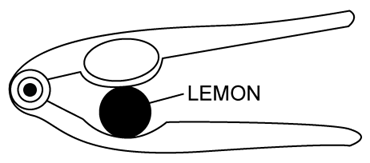
Solution 28
(a)
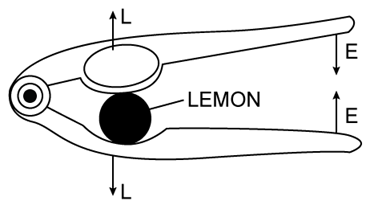
(b) It is class II lever.
Question 29
The diagram below shows a rod lifting a stone. (a) Mark position of fulcrum F and draw arrows to show the directions of load L and effort E. (b) What class of lever is the rod? (c) Give one more example of the same class of lever stated in part (b).
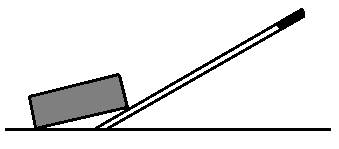
Solution 29
a)
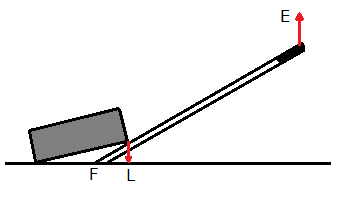
b) This rod is a class II lever as load is between fulcrum and effort.
c) An example of class II lever is a bottle opener.
Question 30
State the kind of lever which always has the mechanical advantage less than 1. Draw a labelled diagram of such lever.
Solution 30
Classes III levers always have mechanical advantage less than one.
Diagram:
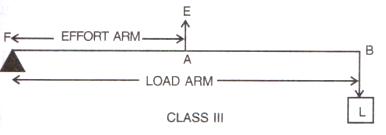
Question 31
Explain why the mechanical advantage of the class III type of lever is always less than 1.
Solution 31
In these types of levers, the effort is in between the fulcrum F and the load L and so the effort arm is always smaller than the load arm. Therefore M.A. < 1.
Question 32
Classes III levers have mechanical advantage less than 1. Why are they then used?
Solution 32
With levers of class III, we do not get gain in force, but we get gain in speed, that is a longer displacement of load is obtained by a smaller displacement of effort.
Question 33
Draw a labelled sketch of a class III lever. Give one example of this kind of lever.
Solution 33
Diagram:
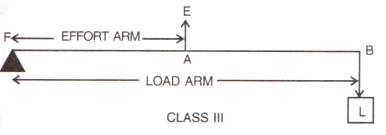
Examples: foot treadle.
Question 34
State the class of levers and the relative positions of load (L), effort (E) and fulcrum (F) in (a) a bottle opener, and (b) sugar tongs.
Solution 34
(a) A bottle opener is a lever of the second order, as the load is in the middle, fulcrum at one end and effort at the other.

Bottle opener
(b) Sugar tongs is a lever of the third order as the effort is in the middle, load at one end and fulcrum at the other end.
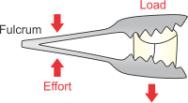
Sugar tongs
Question 35
Draw diagrams to illustrate the position of fulcrum, load and effort, in each of the following:
(a)A seesaw
(b)A common balance
(c)A nut cracker
(d)Forceps.
Solution 35
(a)A seesaw
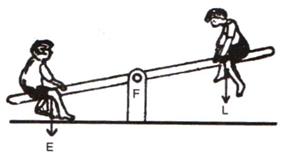
(b)A common balance
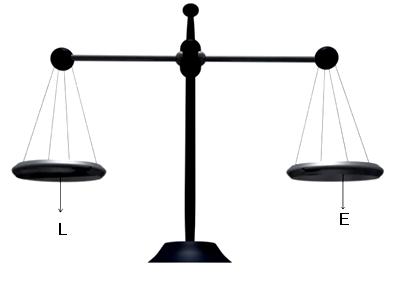
(c)A nut cracker
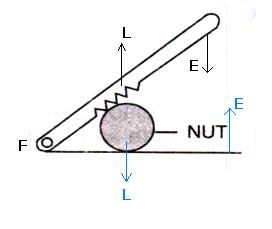
(d)Forceps.
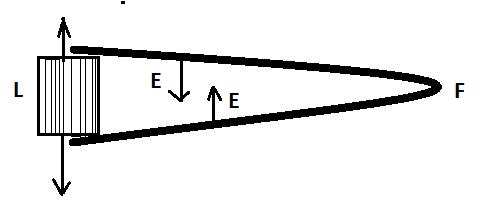
Question 36
Classify the following into levers as class I, class II or class III:
(a) A door (b) a catapult (c) a wheel barrow (d) a fishing rod.
Solution 36
a. Class II
b. Class I
c. Class II
d. Class III
Question 37
What type of lever is formed by the human body while (a) raising a load on the palm, and (b) raising the weight of body on toes?
Solution 37
(a) Class III.
Here, the fulcrum is the elbow of the human arm. Biceps exert the effort in the middle and load on the palm is at the other end.
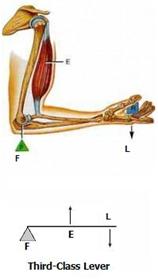
(b) Class II.
Here, the fulcrum is at toes at one end, the load (i.e. weight of the body) is in the middle and effort by muscles is at the other end.
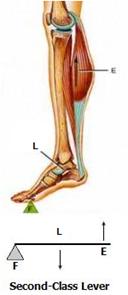
Question 38
Indicate the positions of load L, effort E and fulcrum F in the forearm shown below. Name the class of lever.
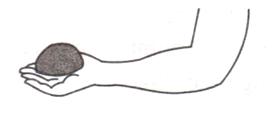
Solution 38
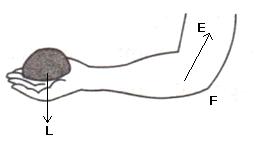
It is Class III lever.
Question 39
Give example of each class of lever in a human body.
Solution 39
- Class I lever in the action of nodding of the head: In this action, the spine acts as the fulcrum, load is at its front part, while effort is at its rear part.
- Class II lever in raising the weight of the body on toes: The fulcrum is at toes at one end, the load is in the middle and effort by muscles is at the other end.
- Class III lever in raising a load by forearm: The elbow joint acts as fulcrum at one end, biceps exerts the effort in the middle and a load on the palm is at the other end.
Question 40
Complete the following sentences:
(a) Mechanical advantage = ___________ × velocity ratio
(b) In class II lever, effort arm is __________ than the load arm.
(c) A scissors is a ___________ multiplier.
Solution 40
(a) Mechanical advantage = efficiency × velocity ratio
(b) In class II lever, effort arm is greater than the load arm.
(c) A scissors is a speed multiplier.
Question 41
Mechanical advantage (M.A.), load (L) and effort (E) are related as:
a. M.A. = L x E
b. M.A. x E = L
c. E = M.A. x L
d. None of these
Solution 41
M.A. x E = L
Question 42
The correct relationship between the mechanical advantage (M.A.), velocity ratio (V.R.) and efficiency ( ) is:
) is:
a. M.A. =  x V.R.
x V.R.
b. V.R. =  x M.A.
x M.A.
c.  =M.A. x V.R.
=M.A. x V.R.
d. None of these
Solution 42
M.A. =  x V.R.
x V.R.
Question 43
State the incorrect statement:
- A machine always has the efficiency less than 100%.
- The mechanical advantage of a machine can be less than 1.
- A machine can be used as speed multiplier.
- A machine can have the mechanical advantage greater than the velocity ratio.
Solution 43
It can have a mechanical advantage greater than the velocity ratio.
Reason: If the mechanical advantage of a machine is greater than its velocity ratio, then it would mean that the efficiency of a machine is more than 100%, which is practically not possible.
Question 44
The lever for which the mechanical advantage is less than 1 has the :
- Fulcrum at mid-point between load and effort.
- Load between effort and fulcrum.
- Effort between fulcrum and load.
- Load and effort acting at the same point.
Solution 44
Effort is between fulcrum and load
Hint: Levers, for which the mechanical advantage is less than 1, always have the effort arm shorter than the load arm.
Question 45
Class II levers are designed to have:
a. M.A. = V.R.
b. M.A. > V.R.
c. M.A. > 1
d. M.A. < 1
Solution 45
Hint: In class II levers, the load is in between the effort and fulcrum. Thus, the effort arm is always longer than the load arm and less effort is needed to overcome a large load. Hence, 
Question 46
A crowbar of length 120 cm has its fulcrum situated at a distance of 20 cm from the load. Calculate the mechanical advantage of the crowbar.
Solution 46
Total length of crowbar =120 cm
Load arm =20 cm
Effort arm = 120-20 =100 cm
Mechanical advantage 
Question 47
A pair of scissors has its blades 15 cm long, while its handles are 7.5 cm long. What is its mechanical advantage?
Solution 47
Effort arm = 7.5 cm
Load arm = 15 cm
Mechanical advantage
Question 48
A force of 5kgf is required to cut a metal sheet. A shears used for cutting the metal sheet has its blades 5 cm long, while its handle is 10 cm long. What effort is needed to cut the sheet?
Solution 48
Effort arm = 10 cm
Load arm = 5 cm
Mechanical advantage=
Load=5kgf
Question 49
The diagram below shows a lever in use.
- To which class of lever does it belong?
- If AB =1 m, AF= 0.4 m, find its mechanical advantage.
- Calculate the value of E.

Solution 49
(a)This is a class I lever.
(b)Given AB=1m, AF=0.4m and BF=0.6 m
Mechanical advantage
(c)Load =15kgf
Question 50
A man uses a crowbar of length 1.5 m to raise a load of 75kgf by putting a sharp edge below the bar at a distance 1 m from his hand. (a) Draw a diagram of the arrangement showing the fulcrum (F), load (L) and effort (E) with their directions. (b) State the kind of lever. (c) Calculate: (i) load arm, (ii) effort arm, (iii) mechanical advantage, and (iv) the effort needed.
Solution 50
Diagram:
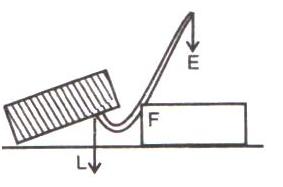
Crowbar is a class I lever.
(i)Total length of crowbar =1.5m
Effort arm = 1 m
Load arm = 1.5-1 =0.5 m
(ii)Effort arm= 1m
(iii)Mechanical advantage
(iv)The effort needed
Question 51
A pair of scissors is used to cut a piece of a cloth by keeping it at a distance 8.0 cm from its rivet and applying an effort of 10 kgf by fingers at a distance 2.0 cm from the rivet.
(a) Find: (i) the mechanical advantage of scissors and (ii) the load offered by the cloth.
(b) How does the pair of scissors act: as a force multiplier or as a speed multiplier?
Solution 51
Effort arm = 2 cm
Load arm = 8.0 cm
Given effort =10kgf
(i)Mechanical advantage 
(ii)
The pair of scissors acts as a speed multiplier because MA < 1.
Question 52
A 4 m long rod of negligible weight is to be balanced about a point 125 cm from one end and A load of 18 kgf is suspended at a point 60 cm from the support on the shorter arm.
(a) If a weight W is placed at a distance of 250 cm from the support on the longer arm, Find W.
(b) If a weight 5 kgf is kept to balance the rod, find its position.
(c) To which class of lever does it belong?
(b) If a weight 5 kgf is kept to balance the rod, find its position.
(c) To which class of lever does it belong?
Solution 52
Total length of rod = 4 m = 400 cm
(a)18kgf load is placed at 60 cm from the support.
W kgf weight is placed at 250 cm from the support.
By the principle of moments
18 x 60 = W x 250
W = 4.32 kgf
(b)Given W=5 kgf
18kgf load is placed at 60 cm from the support.
Let 5 kgf of weight is placed at d cm from the support.
By the principle of moments
18 x 60 = 5 x d
d = 216 cm from the support on the longer arm
(c)It belongs to class I lever.
Question 53
A lever of length 9 cm has its load arm 5 cm long and the effort arm is 9 cm long. (a) To which class does it belong? (b) Draw diagram of the lever showing the position of fulcrum F and directions of both the load L and effort E. (c) What is the mechanical advantage and velocity ratio if the efficiency is 100%? (d) What will be the mechanical advantage and velocity ratio if the efficiency becomes 50%?
Solution 53
(a) Length of the lever is same as the effort arm. Also, effort arm is more than load arm. So, this is a class II lever.
(b)

(c) Mechanical advantage is

Relation between MA, efficiency and V.R. is
(d) When efficiency reduces, its mechanical advantage reduces and velocity ratio remains the same. So, when efficiency becomes 50%, M.A. = 0.9 and V.R. = 1.8
Question 54
The diagram below shows a lever in use.
(a) To which class of lever does it belong?
(b) If FA = 80 cm, AB = 20 cm, find its mechanical advantage.
(c) Calculate the value of E.
(b) If FA = 80 cm, AB = 20 cm, find its mechanical advantage.
(c) Calculate the value of E.
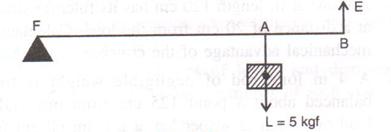
Solution 54
(a) This is a class II lever.
(b) Given: FA=80 cm, AB = 20 cm, BF = FA + AB = 100 cm
Mechanical advantage 
(c) 
Question 55
The figure shows a wheel barrow of mass 15 kg carrying a load of 30 kgf with its center of gravity at A. The points B and C are the centre of wheel and tip of the handle such that the horizontal distance AB = 20 cm and AC = 40 cm.
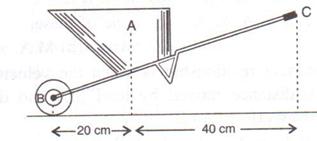
Find: (a) the load arm, (b) the effort arm, (c) the mechanical advantage, and (d) the
minimum effort required to keep the leg just off the ground.
Solution 55
(a) (i) Load arm AF=20 cm
(ii)Effort arm CF=60 cm
(iii)Mechanical advantage 
(iv)Total load =30+15 = 45 kgf
Question 56
The diagram below shows the use of a lever.

(a) State the principle of moments as applied to the above lever.
(b) To which class of lever does it belong? Give an example of this class of lever.
(c) If FA = 10cm, AB = 490cm, calculate: (i) the mechanical advantage, and (ii) the minimum effort required to lift the load (= 50N).
Solution 56
(a)The principle of moments: Moment of the load about the fulcrum=moment of the effort about the fulcrum
FB x Load = FA x Effort
(b)Class III;Sugar tongs the example of this class of lever.
(c)Given: FA=10 cm, AB = 500 cm, BF =490+10=500 cm.
The mechanical advantage
The minimum effort required to lift the load

Question 57
A fire tongs has its arms 20 cm long. It is used to lift a coal of weight 1.5kgf by applying an effort at a distance 15 cm from the fulcrum. Find: (i) the mechanical advantage of fire tongs and (ii) the effort needed.
Solution 57
Fire tongs has its arms =20 cm
Effort arm = 15 cm
Load arm =20 cm
(i)Mechanical advantage 
(ii) .
.
Chapter 3 - Machines Exercise Ex. 3B
Question 1
What is a fixed pulley? State its one use.
Solution 1
Fixed pulley: A pulley which has its axis of rotation fixed in position, is called a fixed pulley.
Single fixed pulley is used in lifting a small load like water bucket from the well.
Question 2
What is the ideal mechanical advantage of a single fixed pulley? Can it be used as a force multiplier?
Solution 2
The ideal mechanical advantage of a single fixed pulley is 1.
It cannot be used as force multiplier.
Question 3
Name the pulley which has no gain in mechanical advantage. Explain, why is such a pulley is then used?
Solution 3
There is no gain in mechanical advantage in the case of a single fixed pulley. A single fixed pulley is used only to change the direction of the force applied that is with its use, the effort can be applied in a more convenient direction. To raise a load directly upwards is difficult.
Question 4
What is the velocity ratio of a single fixed pulley?
Solution 4
The velocity ratio of a single fixed pulley is 1.
Question 5
In a single fixed pulley, if the effort moves by a distance x downwards, by what height is the load raised upwards?
Solution 5
The load rises upwards with the same distance x.
Question 6
What is a single movable pulley? What is its mechanical advantage in the ideal case?
Solution 6
Single movable pulley: A pulley, whose axis of rotation is not fixed in position, is called a single movable pulley.
Mechanical advantage in the ideal case is 2.
Question 7
Name the type of single pulley that has an ideal mechanical advantage equal to 2. Draw a labeled diagram of the pulley mentioned by you.
Solution 7
A single movable pulley act as a force multiplier.
Diagram:
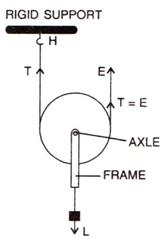
Question 8
Give two reasons why the efficiency of a single movable pulley system is not 100%.
Solution 8
The efficiency of a single movable pulley system is not 100% this is because
(i)The friction of the pulley bearing is not zero ,
(ii)The weight of the pulley and string is not zero.
Question 9
In which direction the force need be applied, when a single pulley is used with a mechanical advantage greater than 1? How can you change the direction of force applied without altering its mechanical advantage? Draw a labelled diagram of the system.
Solution 9
The force should be in upward direction.
The direction of force applied can be changed without altering its mechanical advantage by using a single movable pulley along with a single fixed pulley to change the direction of applied force.
Diagram:
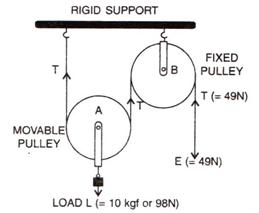
Question 10
What is the velocity ratio of a single movable pulley? How does the friction in the pulley bearing affect it?
Solution 10
The velocity ratio of a single movable pulley is always 2.
Question 11
In a single movable pulley, if the effort moves by a distance x upwards, by what height is the load raised?
Solution 11
The load is raised to a height of x/2.
Question 12
Draw a labelled diagram of an arrangement of two pulleys, one fixed and other moveable. In the diagram, mark the directions of all forces acting on it. What is the ideal mechanical advantage of the system? How can it be achieved?
Solution 12
Diagram:
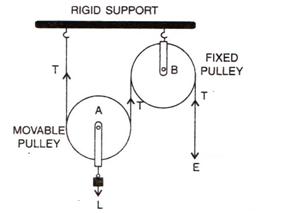
Ideal mechanical advantage of this system is 2. This can be achieved by assuming that string and the pulley are massless and there is no friction in the pulley bearings or at the axle or between the string and surface of the rim of the pulley.
Question 13
The diagram alongside shows a pulley arrangement.
(a) Name the pulleys A and B.
(b) In the diagram, mark the direction of tension on each strand of string.
(c) What is the purpose of the pulley B?
(d) If the tension is T, deduce the relation between (i) T and E, and (ii) E and L.
(e) What is the velocity ratio of the arrangement?
(f) Assuming that the efficiency of the system is 100%, what is the mechanical advantage?
(b) In the diagram, mark the direction of tension on each strand of string.
(c) What is the purpose of the pulley B?
(d) If the tension is T, deduce the relation between (i) T and E, and (ii) E and L.
(e) What is the velocity ratio of the arrangement?
(f) Assuming that the efficiency of the system is 100%, what is the mechanical advantage?
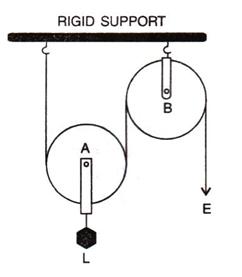
Solution 13
(a)
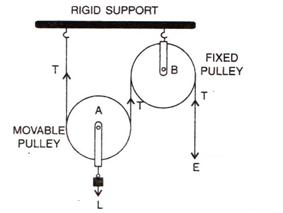
(b)The fixed pulley B is used to change the direction of effort to be applied from upward to downward.
(c)The effort E balances the tension T at the free end, so E=T
(d)The velocity ratio of this arrangement is 2.
(e)The mechanical advantage is 2 for this system (if efficiency is 100%).
Question 14
State four differences between a single fixed pulley and a single movable pulley.
Solution 14
Single fixed pulley
|
Single movable pulley
|
1.It is fixed to a rigid support.
|
1.It is not fixed to a rigid support.
|
2.Its mechanical advantage is one.
|
2.Its mechanical advantage istwo.
|
3.Its velocity ratio is one.
|
3.Its velocity ratio is two.
|
4.The weight of pulley itself does not affect its mechanical advantage.
|
4. The weight of pulley itself reduces its mechanical advantage.
|
5.It is used to change the direction of effort
|
5.It is used as force multiplier.
|
Question 15
The diagram alongside shows and arrangement of three pulleys A, B and C. The load is marked as L and the effort as E.
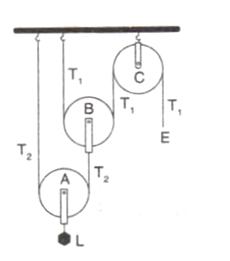
(a) Name the pulleys A, B and C.
(b) Mark in the diagram the direction of load (L), effort (E) and tension T1 and T2 in the two strings.
(c) How are the magnitudes of L and E related to the tension T1?
(d) Calculate the mechanical advantage and velocity ratio of the arrangement.
(e) What assumptions have you made in parts (c) and (d)?
Solution 15
(a) Pulleys A and B are movable pulleys. Pulley C is fixed pulley.
(b)
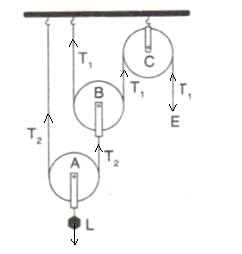
(c) The magnitude of effort E = T1
And the magnitude of L= 22 T1 = 4 T1
(d)The mechanical advantage = 22 = 4
The velocity ratio = 22 = 4
(e)Assumption: the pulleys A and B are weightless.
Question 16
Draw a diagram of combination of three movable pulleys and one fixed pulley to lift up a load. in the diagram, show the directions of load, effort and tension in each strand. Find: (i) the mechanical advantage, (ii) velocity ratio and (iii) the efficiency of the combination in ideal situation.
Solution 16
Diagram:
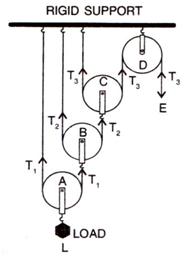
Tension T1 in the string passing over the pulley A is given as
2T1 = L or T1 = L/2
Tension T2 in the string passing over the pulley B is given as
2T2 = T1or T2 = T1/2 = L/22
Tension T3 in the string passing over the pulley C is given as
2T3 = T2orT3 = T2/2 = L/23
In equilibrium, T3 = E
E =L/23
Mechanical advantage = MA = L/E = 23
As one end of each string passing over a movable pulley is fixed, so the free end of string moves twice the distance moved by the movable pulley.
If load L moves up by a distance x, dL = x, effort moves by a distance 23x, dE = 23x
Velocity Ratio VR =
Efficiency = MA/VR =23/ 23 = 1 or 100%
Question 17
Draw a diagram of a block and tackle system of pulleys having a velocity ratio of 5. In your diagram indicate clearly the points of application and the directions of the load L and effort E. Also mark the tension T in each strand.
Solution 17
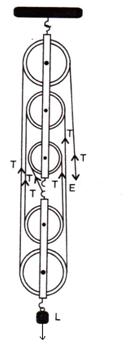
Question 18
Give reasons for the following :
(a) In a single fixed pulley, the velocity ratio is always more than the mechanical advantage.
(b) The efficiency of a movable pulley is always less than 100%.
(c) In case of block and tackle system, the mechanical advantage increases with the increase in the number of pulleys.
(d) The lower block of a block and tackle pulley system must be of negligible weight.
(b) The efficiency of a movable pulley is always less than 100%.
(c) In case of block and tackle system, the mechanical advantage increases with the increase in the number of pulleys.
(d) The lower block of a block and tackle pulley system must be of negligible weight.
Solution 18
(a) In a single fixed pulley, some effort is wasted in overcoming friction between the strings and the grooves of the pulley; so the effort needed is greater than the load and hence the mechanical advantage is less than the velocity ratio.
(b) This is because of some effort is wasted in overcoming the friction between the strings and the grooves of the pulley.
(c) This is because mechanical advantage is equal to the total number of pulleys in both the blocks.
(d) The efficiency depends upon the mass of lower block; therefore efficiency is reduced due to the weight of the lower block of pulleys.
(b) This is because of some effort is wasted in overcoming the friction between the strings and the grooves of the pulley.
(c) This is because mechanical advantage is equal to the total number of pulleys in both the blocks.
(d) The efficiency depends upon the mass of lower block; therefore efficiency is reduced due to the weight of the lower block of pulleys.
Question 19
Name the machine which is used to:
(a)Multiply force
(b)Multiplied speed, and
(c)Change the direction of force applied.
Solution 19
(a)Multiply force: a movable pulley.
(b)Multiply speed: gear system or class III lever.
(c)Change the direction of force applied: single fixed pulley.
Question 20
State whether the following statements are true or false.
- The velocity ratio of a single fixed pulley is always more than 1.
- The velocity ratio of a single movable pulley is always 2.
- The velocity ratio of a combination of n movable pulleys with a fixed pulley is always 2n.
- The velocity ratio of a block and tackle system is always equal to the number of strands of the tackle supporting the load.
Solution 20
- The velocity ratio of a single fixed pulley is always more than 1.(false)
- The velocity ratio of a single movable pulley is always 2.(true)
- The velocity ratio of a combination of n movable pulleys with a fixed pulley is always 2n.(true)
- The velocity ratio of a block and tackle system is always equal to the number of strands of the tackle supporting the load. (true)
Question 21
A single fixed pulley is used because it:
(a) Has a mechanical advantage greater than 1
(b) Has a velocity ratio less than 1
(c) Gives 100% efficiency
(d) Helps to apply the effort in a convenient direction.
(b) Has a velocity ratio less than 1
(c) Gives 100% efficiency
(d) Helps to apply the effort in a convenient direction.
Solution 21
It helps in applying effort in a convenient direction.
Explanation: A single fixed pulley though does not reduce the effort but helps in changing the direction of effort applied. As it is far easier to apply effort in downward direction, the single fixed pulley is widely used.
Question 22
The mechanical advantage of an ideal single movable pulley is:
(a) 1
(b) 2
(3) less than 2
(4) less than 1.
(b) 2
(3) less than 2
(4) less than 1.
Solution 22
The mechanical advantage of an ideal single movable pulley is 2.
Derivation: Consider the diagram given below:
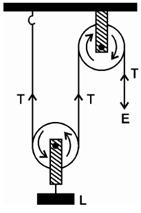
Here the load L is balance by the tension in two segments of the string and the effort E balances the tension T at the free end, so
L = T + T = 2T and E = T
Assumption: Weight of the pulley is negligible.
We know that,
Thus, a single movable pulley has a M.A. equal to 2.
Question 23
A movable pulley is used as :
(a) a force multiplier
(b) a speed multiplier
(c) a device to change the direction of effort
(d) an energy multiplier
(b) a speed multiplier
(c) a device to change the direction of effort
(d) an energy multiplier
Solution 23
Force multiplier
Explanation: The mechanical advantage of movable pulley is greater than 1. Thus, using a single movable pulley, the load can be lifted by applying an effort equal to half the load (in ideal situation), i.e. the single movable pulley acts as a force multiplier.
Question 24
A woman draws water from a well using a fixed pulley. The mass of bucket and water together is 6 kg. The force applied by the women is 70 N. calculate the mechanical advantage. (Take g = 10 m s-2).
Solution 24
The force applied by the women is= 70 N
The mass of bucket and water together is = 6 kg
Total load = 6 x 10 = 60 N
Mechanical advantage 
Question 25
A fixed pulley is driven by a 100 kg mass falling at a rate of 8.0 m in 4.0 s. It lifts a load of 75.0 kgf. Calculate:
(a) The power input to the pulley taking the force of gravity on 1 kg as 10 N.
(b) the efficiency of the pulley, and
(c) the height to which the load is raised in 4.0 s.
Solution 25
(a) Effort driving the pulley is, E = mg = 100 × 10 = 1000 N
Input power is

(b) Load pulled by the pulley is L = 75 × 10 = 750 N
Therefore, M.A. is
When the effort moves by a distance d downwards, the load moves by the same distance upwards. So, V.R. = 1
Hence, efficiency is
(c) When the effort moves by a distance d downwards, the load moves by the same distance upwards. So, height to which the load moves is 8 m.
Question 26
A single fixed pulley and a movable pulley both are separately used to lift a load of 50 kgf to the same height. Compare the efforts applied.
Solution 26
In case of a single fixed pulley, the effort (Ef needed to lift a load) is equal to the load itself.
Thus, Ef = L
→ Ef = 50 kgf
In case of a single movable pulley, the effort needed to lift a load is equal to half the load.
→ Em =
→ 
Thus, the ratio of efforts applied by the respective pulley is
Ef:Em = 2:1
Question 27
In a block and tackle system consisting of 3 pulleys, a load of 75 kgf is raised with an effort of 25 kgf. Find: (i) the mechanical advantage, (ii) the velocity ratio, and (iii) the efficiency.
Solution 27
Load = 75 kgf
Effort=25kgf
n = 3
MA = Load/Effort = 75/25 = 3
or MA = n = 3
velocityratio VR= n = 3
Efficiency  or 100%
or 100%
Question 28
A block and tackle system has 5 pulleys. If an effort of 1000 N is needed in the downward direction to raise a load of 4500 N, calculate:
(a)The mechanical advantage,
(b)The velocity ratio and,
(c)The efficiency of the system.
Solution 28
A block and tackle system has 5 pulleys. (n = 5)
Effort=1000 N
Load=4500 N
(a)The mechanical advantage 
(b)The velocity ratio = n =5
(c)The efficiency of the system
Question 29
In figure draw a tackle to lift the load by applying the force in the download direction.
(a) Mark in the diagram the direction of load L and effort E.
(b) If the load is raised by 1 m, through what distance will the effort move?
(c) State how many strands of tackle are supporting the load.
(d) What is the mechanical advantage of the system?

Solution 29
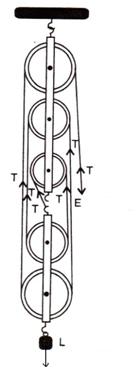
(a)The effort move = 1 x 5 = 5m
(b)Five strands of tackle are supporting the load.
(c)Mechanical advantage of the system =
Question 30
A pulley system has a velocity ratio 3. Draw a diagram showing the point of application and direction of load (L), effort (E) and tension (T). If lifts a load of 150 N by an effort of 60 N. Calculate its mechanical advantage. Is the pulley system ideal? Give reason.
Solution 30
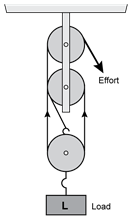
Load= 150N
Effort=60N
Mechanical advantage=L/E=150/60=2.5
The pulley system is not ideal because the mechanical advantage is less than 3.
Question 31
Figure shows a system of four pulleys. The upper two pulleys are fixed and the lower two are movable.
(a) Draw a string around the pulleys. Also show the point of application and direction in which the effort E is applied.
(b) What is the velocity ratio of the system?
(c) How are load and effort of the pulley system related?
(d) What assumption do you make in arriving at your answer in part (c)?
(b) What is the velocity ratio of the system?
(c) How are load and effort of the pulley system related?
(d) What assumption do you make in arriving at your answer in part (c)?

Solution 31
(a)

(b)Velocity ratio of the system = n = 4
(c)The relation between load and effort
MA = 
(d)(i) There is no friction in the pulley bearings, (ii) weight of lower pulleys is negligible and (iii) the effort is applied downwards.
Question 32
Figure shows a block and tackle system of pulleys used to lift a load.
(a) How many strands of tackle are supporting the load?
(b) Draw arrows to represent tension T in each strand.
(c) What is the mechanical advantage of the system?
(d) When load is pulled up by a distance 1 m, how far does the effort end move?
(e) How much effort is needed to lift a load of 100 N?
(b) Draw arrows to represent tension T in each strand.
(c) What is the mechanical advantage of the system?
(d) When load is pulled up by a distance 1 m, how far does the effort end move?
(e) How much effort is needed to lift a load of 100 N?

Solution 32
(a)There are 4 strands of tackle supporting the load.
(b)
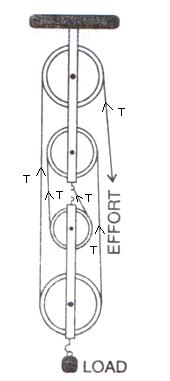
(c)The mechanical advantage of the system
(d)When load is pulled up by a distance 1 m, the effort end will move by a distance = 1x4 = 4m.
Question 33
A block and tackle system has the velocity ratio 3. Draw a labelled diagram of the system indicating the points of application and the directions of load L and effort E. A man can exert a pull of 200 kgf. (a) What is the maximum load he can raise with this pulley system if its efficiency is 60%? (b) If the effort end moves a distance 60 cm, what distance does the load move?
Solution 33
For block and tackle system, V.R. = n (number of pulleys)
Hence, n = 3
The diagram is as shown below

(a) The effort put by man is E = 200 kgf
Efficiency is η = 60%
For block and tackle system,

Hence, load is
(b) The velocity ratio of system is V.R. = 3
Hence, we get

Question 34
You are given four pulleys and three strings. Draw a neat and labelled diagram to use them so as to obtain a maximum mechanical advantage equal to 8. In your diagram mark the directions of load L, effort E and tension in each strand.
What assumptions have you made to obtain the required mechanical advantage?
[Hint: Three movable pulleys with one fixed pulley]
Solution 34
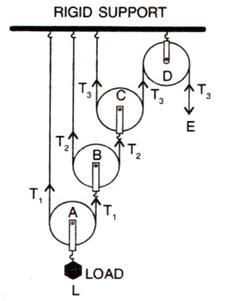
Assumptions: (i) There is no friction in the pulley bearing, (ii) the pulleys and the string are massless.
Comments
Post a Comment